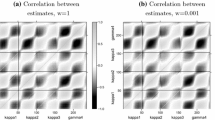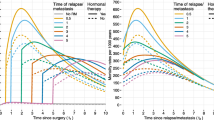Abstract
Many systems involve progression through a series of distinct stages, such as disease or developmental stages. In ecological studies, often individuals such as small arthropods cannot be marked, so data are collected on cohort development. Multistage models for unmarked cohort data use a distribution for each stage duration and possibly stage-specific mortality rates. We generalize previous models and present computational methods for smoothed maximum likelihood estimation. The general model allows arbitrary distribution assumptions, stage-specific mortality, unobserved stages, and correlations between stage durations using Gaussian copulas. Monte Carlo integration of the stage distributions is used to approximate the probabilities needed for the likelihood. We establish a heuristic smoothing step for the simulated probabilities that yields a smooth approximate likelihood surface. For the case of classic grasshopper cohort data, we demonstrate AIC model selection to determine which among past arbitrary constraints are actually justified by the data. Finally, we demonstrate how estimates of stage distribution parameters depend on the unknown stage correlations.



Similar content being viewed by others
References
Aksnes, D. L., C. B. Miller, M. D. Ohman, and S. N. Wood (1997). Estimation techniques used in studies of copepod population dynamics: a review of underlying assumptions. Sarsia 82(4), 279–296.
Ashford, J. R., K. L. Q. Read, and G. G. Vickers (1970). A system of stochastic models applicable to studies of animal population dynamics. Journal of Animal Ecology 39(1), 29–50.
Aubry, A., E. Bécart, J. Davenport, and M. C. Emmerson (2010). Estimation of survival rate and extinction probability for stage-structured populations with overlapping life stages. Population Ecology 52, 437–450.
Bellows, T. S. and M. H. Birley (1981). Estimating developmental and mortality rates and stage recruitment from insect stage-frequency data. Researches on Population Ecology 23(2), 232–244.
Dennis, B., W. P. Kemp, and R. C. Beckwith (1986). Stochastic model of insect phenology: estimation and testing. Environmental Entomology 15(3), 540–546.
Diggle, P. J. and R. J. Gratton (1984). Monte Carlo methods of inference for implicit statistical models. Journal of the Royal Statistical Society Series B-Methodological 46(2), 193–227.
Hairston, N. G. J. and S. Twombly (1985). Obtaining life table data from cohort analyses: a critique of current methods. Limnology and Oceanography 30(4), 886–893.
Hoeting, J. A., R. L. Tweedie, and C. S. Olver (2003). Transform estimation of parameters for stage-frequency data. Journal of the American Statistical Association 98(463), 503–514.
Hougaard, P. (2000). Analysis of multivariate survival data. New York: Springer.
Jellison, R., G. L. Dana, and J. M. Melack (1995). Zooplankton cohort analysis using systems identification techniques. Journal of Plankton Research 17(11), 2093–2115.
Kemp, W. P., B. Dennis, and R. C. Beckwith (1986). Stochastic phenology model for the western spruce budworm (Lepidoptera: tortricidae). Environmental Entomology 15(3), 547–554.
Kempton, R. A. (1979). Statistical analysis of frequency data obtained from sampling an insect population grouped by stages. In J. K. Ord, G. P. Patil, and C. Taillie (Eds.), Statistical Distributions in Ecological Work, pp. 401–418. Fairland, Maryland: International Co-operative Publishing House.
Kimmerer, W. and A. Gould (2010). A Bayesian approach to estimating copepod development times from stage frequency data. Limnology and Oceanography: Methods 8, 118–126.
Kiritani, K. and F. Nakasuji (1967). Estimation of the stage-specific survival rate in the insect population with overlapping stages. Researches on Population Ecology 9, 143–152.
Lefkovitch, L. P. (1965). The study of population growth in organisms grouped by stages. Biometrics 21(1), 1–18.
Leslie, P. H. (1945). On the use of matrices in certain population mathematics. Biometrika 33(3), 183–212.
——— (1948). Some further notes on the use of matrices in population mathematics. Biometrika 35(3/4), 213–245.
MacKenzie, D. I., J. D. Nichols, M. E. Seamans, and R. J. Gutiérrez (2009). Modeling species occurrence dynamics with multiple states and imperfect detection. Ecology 90(3), 823–835.
Manly, B. F. J. (1990). Stage-structured populations: sampling, analysis, and simulation. New York: Chapman and Hall.
——— (1997). A method for the estimation of parameters for natural stage-structured populations. Researches on Population Ecology 39(2), 101–111.
Munholland, P. L. and J. D. Kalbfleisch (1991). A semi-Markov model for insect life history data. Biometrics 47(3), 1117–1126.
Murtaugh, P. A., S. C. Emerson, P. B. McEvoy, and K. M. Higgs (2012). The statistical analysis of insect phenology. Environmental Entomology 41(2), 355–361.
Ohman, M. D. (2012). Estimation of mortality for stage-structured zooplankton populations: What is to be done? Journal of Marine Systems 93, 4–10.
Osawa, A., C. A. Shoemaker, and J. R. Stedinger (1983). A stochastic model of balsam fir bud phenology utilizing maximum likelihood parameter estimation. Forest Science 29(3), 478–490.
Qasrawi, H. (1966). A study of the energy flow in a natural population of the grasshopper Chorthippus parallelus Zett. (Orthoptera: Acrididae). Unpublished Ph.D. thesis, University of Exeter.
Read, K. L. Q. and J. R. Ashford (1968). A system of models for life cycle of a biological organism. Biometrika 55(1), 211–221.
Rigler, F. H. and J. M. Cooley (1974). Use of field data to derive population statistics of multivoltine copepods. Limnology and Oceanography 19(4), 636–655.
Stedinger, J. R., C. A. Shoemaker, and R. F. Tenga (1985). A stochastic model of insect phenology for a population with spatially variable development rates. Biometrics 41(3), 691–701.
Wood, S. N. and R. M. Nisbet (1991). Estimation of mortality rates in stage-structured populations. Berlin: Springer.
Yamamura, K. (1998). A simple method to estimate insect mortality from field census data: A modification of the Kiritani-Nakasuji-Manly method. Researches on Population Ecology 40(3), 335–340.
Acknowledgments
This work was partially supported by U.S. National Science Foundation Grant DEB-1021553.
Author information
Authors and Affiliations
Corresponding author
Rights and permissions
About this article
Cite this article
de Valpine, P., Knape, J. Estimation of General Multistage Models From Cohort Data. JABES 20, 140–155 (2015). https://doi.org/10.1007/s13253-014-0189-7
Published:
Issue Date:
DOI: https://doi.org/10.1007/s13253-014-0189-7




